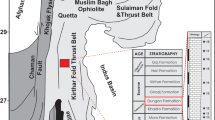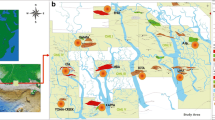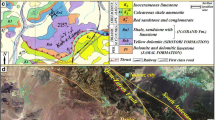Abstract
The present study integrates the facies and planktonic foraminiferal biostratigraphic data to construct a sequence stratigraphic model of the Mughal Kot Formation of Maastrichtian age in the Lower Indus Basin, Pakistan. The Mughal Kot Formation is comprised of 1000-m-thick sequence of hemipelagic sediments, interrupted by random influxes of coarse-grained sandy turbidites. The petrographic details revealed six sub-microfacies, indicating deposition in the middle shelf, slope and deep marine basin. The sequence stratigraphic model is based on the integration of biostratigraphic age and local depositional signals in the study area. The studied sedimentary succession is divided into one second-order and two third-order cycles while ten parasequences are identified within the complete cycles of transgressive, highstand and lowstand systems tracts. The depositional trends within the relative sea level curve of the Maastrichtian strata of the study area and the global sea level charts are quite dissimilar, which suggest a sustained transgression with pulsated tectonics in Lower Indus Basin. The integrated results of plug porosity/permiability and petrography reveal poor reservoir potential for the sandy turbidites and pelagic carbonates of the Mughal Kot Formation.






Similar content being viewed by others
References
Acharyya S (2007) Evolution of the Himalayan Paleogene foreland basin, influence of its litho-packet on the formation of thrust related domes and windows in the Eastern Himalayas—a review. J Asian Earth Sci 31:1–17
Anwar M, Fatmi A, Hyderi I (1991) Revised nomenclature and stratigraphy of Ferozabad, Alozai and Mona Jhal Groups of Balochistan (Axial Belt), Pakistan. Acta Mineral Pakistan 5:46–61
Banks C, Warburton J (1986) ‘Passive-roof’duplex geometry in the frontal structures of the Kirthar and Sulaiman mountain belts, Pakistan. J Struct Geol 8:229–237
Bannert D, Cheema A, Ahrnad A (1989) Interpretation of landsat-MSS imagery of the Sulaiman and Kirthar Mountain ranges in western Pakistan: a technical report of a co-operative project between Bundesanstalt fur Geowissenschafien und Rohstoffe, Hannover, West Germany and Hydrocarbon Development Institute of Pakistan, Project No.83.2068.1
Bender FK, Raza HA (1995) Geology of Pakistan. Beträge zur regionalen Geologie der Erde. Gebrüder Borntraeger Berlin, vol 25
Blatt H (1992) Sedimentary Petrology. Freeman and Co, New York, p 514
Carter RM, Fulthorpe CS, Naish TR (1998) Sequence concepts at seismic and outcrop scale: the distinction between physical and conceptual stratigraphic surfaces. Sediment Geol 122:165–179
Catuneanu O et al (2009) Towards the standardization of sequence stratigraphy. Earth Sci Rev 92:1–33
Chen F, Siebel W, Satir M, Terzioğlu M, Saka K (2002) Geochronology of the Karadere basement (NW Turkey) and implications for the geological evolution of the Istanbul zone. Int J Earth Sci 91:469–481
Dorreen JM (1974) The Western Gaj River section, Pakistan and Cretaceous-Tertiary boundary. Micropaleontology 20:178–193
Dunham RJ (1962) Classification of carbonate rocks according to depositional texture. In: Ham WE (ed) Classification of carbonate rocks, vol 1. Memoir American Association of Petroleum Geologists, pp 108–121
Emery D, Myers K (2009) Sequence stratigraphy. Wiley, Hoboken
Flügel E (2004) Microfacies of carbonate rocks-analysis, interpretation andapplication. Springer, Berlin, pp 1–976
Gnos E, Immenhauser A, Peters T (1997) Late Cretaceous/early tertiary convergence between the Indian and Arabian plates recorded in ophiolites and related sediments. Tectonophysics 271:1–19
Haq BU, Hardenbol J, Vail PR (1988) Mesozoic and Cenozoic chronostratigraphy and cycles of sea-level changes. In: Wilgus CK et al (eds) Sea-level changesóan integrated approach, vol 42. SEMP Special Publication, Houston, pp 71–108
Kadri IB (1995) Petroleum geology of Pakistan. Pakistan Petroleum Limited, Karachi
Khan S (2013) Biostratigraphy and microfacies of the Cretaceous Sediments in the Indus Basin, Pakistan. Ph.D. thesis, University of Edinburgh, Edinburgh, UK
Khan S, Wadood B, Ahmed S, Khan A, Ahmed F, Khan H (2017) Evaluating paleoceanographic and planktonic foraminiferal diversification from the Cretaceous Mughal Kot Formation, Mughal Kot Section, Lower Indus Basin, Pakistan. J Himal Earth Sci 50:27–43
Malkani MS (2010) Updated stratigraphy and mineral potential of Sulaiman Basin, Pakistan. Sindh Univ Res J SURJ (Sci Ser) 42(2):39–66
Marks P (1962) Variation and evolution in orbitoides from the Cretaceous of Rakhi Nala, West Pakistan. Geol Bull Punjab Univ 2:15–29
Peters K (1986) Guidelines for evaluating petroleum source rock using programmed pyrolysis. AAPG Bull 70:318–329
Pettijohn F, Potter P, Siever R (1987) Sand and sandstone, 2nd edn. Springer, New York
Ricci-Lucchi F (2003) Turbidites and foreland basins: an Apenninic perspective. Mar Pet Geol 20:727–732
Scotese CR, Gahagan LM, Larson RL (1988) Plate tectonic reconstructions of the Cretaceous and Cenozoic ocean basins. Tectonophysics 155:27–48
Shafique NA (2001) Spatial biostratigraphy of NW Pakistan. Miami University, Miami
Shah SMI (1977) Stratigraphy of Pakistan. Geol Surv Pakistan Mem, vol 12, pp 1–138
Shah SMI (2009) Stratigraphy of Pakistan. Geol Surv Pakistan Mem, vol 22, pp 1–381
Smewing JD, Warburton J, Daley T, Copestake P, Ul-Haq N (2002) Sequence stratigraphy of the southern Kirthar fold belt and middle Indus basin, Pakistan. Geol Soc Lond Spec Publ 195:273–299
Stow DA, Faugères J-C, Viana A, Gonthier E (1998) Fossil contourites: a critical review. Sediment Geol 115:3–31
Umar M, Friis H, Khan AS, Kassi AM, Kasi AK (2011) The effects of diagenesis on the reservoir characters in sandstones of the Late Cretaceous Pab Formation, Kirthar Fold Belt, southern Pakistan. J Asian Earth Sci 40:622–635
Vail PR (1987) Seismic stratigraphic interpretation using sequence stratigraphy— Part 1: Seismic stratigraphy interpretation procedure. In: Bally AW (ed) Atlas of seismic stratigraphy, vol 27-1. American Association of Petroleum Geologists Studies in Geology, pp 1–10
Van Wagoner JC (1995) Sequence stratigraphy and marine to nonmarine facies architecture of foreland basin strata. Book Cliffs, Utah
Wadood B, Awais M, Khan S, Ahmad S, Ahmad L, Muslim M (2019) Diagenetic studies of the Cretaceous turbidities, Sulaiman Range, Pakistan: implications for reservoir quality. J Himal Earth Sci 52(1):106–119
Waheed A, Wells NA (1990) Changes in paleocurrents during the development of an obliquely convergent plate boundary (Sulaiman fold-belt, southwestern Himalayas, west-central Pakistan). Sediment Geol 67:237–261
Wang Z, Tang S, Chen D, Lins S, Nie F (1996) Basic geological studies and preliminary evaluation of uranium potential of Siwaliks in the middle part of Sulaiman mineral belt Pakistan, an internal report of PAEC Dera Ghazi Khan
Williams MD (1959) Stratigraphy of the Lower Indus Basin, West Pakistan. In: 5th World petroleum congress, 1959. World Petroleum Congress
Zavala C, Arcuri M (2016) Intrabasinal and extrabasinal turbidites: origin and distinctive characteristics. Sediment Geol 337:36–54
Acknowledgements
The authors are thankful to Mr. Abdullah Khan (MS Scholar at NCEG, University of Peshawar) for providing all the facilities and help during field work and Department of Geology, University of Peshawar, for providing laboratory facilities.
Author information
Authors and Affiliations
Corresponding author
Additional information
Publisher's Note
Springer Nature remains neutral with regard to jurisdictional claims in published maps and institutional affiliations.
Rights and permissions
About this article
Cite this article
Wadood, B., Khan, S., Ahmad, S. et al. Sequence stratigraphic framework of the Maastrichtian shelfal to deep marine strata of Lower Indus Basin, Pakistan: implications for the petroleum potential. Carbonates Evaporites 34, 757–769 (2019). https://doi.org/10.1007/s13146-019-00517-z
Accepted:
Published:
Issue Date:
DOI: https://doi.org/10.1007/s13146-019-00517-z




